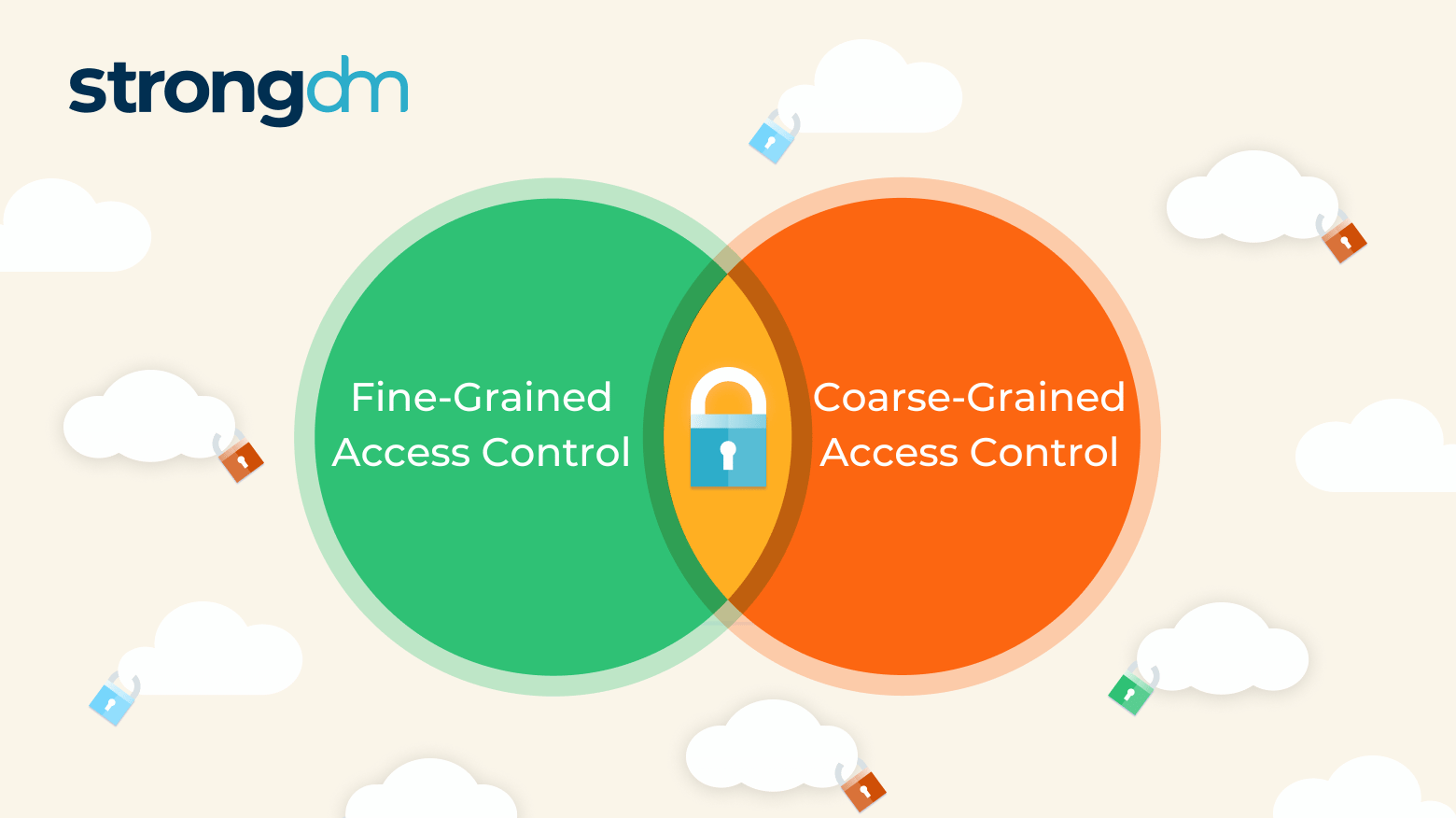

Written by
Fazila MalikLast updated on:
August 29, 2024Reading time:
Contents
Built for Security. Loved by Devs.
- Free Trial — No Credit Card Needed
- Full Access to All Features
- Trusted by the Fortune 100, early startups, and everyone in between
We all know how crucial it is to seal any cracks in the all-important authentication and authorization of access processes. One neglected crevice leaves you vulnerable to a potential security compromise or attack. But the simple act of accessing data or resources should not be a man vs. machine struggle leading to frantic help requests, unauthorized access, and security risk.
If credentials fall into the wrong hands, intruders may enter a network and launch a disastrous attack. In fact, 46% of cybersecurity incidents involve authentication credentials, according to the Verizon 2022 Data Breach Investigations Report. Organizations have two general ways to determine someone’s access rights once past initial authentication: Coarse-grained access control (CGAC), which relies on a single factor, and fine-grained access control (FGAC), which relies on multiple factors. Traditionally, CGAC has been the easier option, while FGAC offers superior security at the cost of more complex implementation.
In this article, we’ll break down the pros and cons of both access-control approaches and explain why organizations today need not compromise on security or ease of use in access control.
Fine-Grained and Coarse-Grained Access Control: What's the Difference?
Fine-grained access control grants or denies access to data or resources based on multiple factors. These factors may include not just role but also seniority, location, and so forth. Additionally, FGAC may take various changeable conditions into account, such as time of day or a user’s recent behavior. Finally, FGAC can limit the amount of data or resources a user can access. For example, a spreadsheet may display some pages, columns, or rows but not others.
Fine-grained access control can be divided into two basic types:
Attribute-based access control (ABAC) grants or denies access based upon attributes such as job role, data sensitivity level, the situational context of the request, or the intended action (for eg., view, copy, edit).
Policy-based access control (PBAC) refers to predetermined policies to grant or deny access, as well as determine the extent of their access.
Coarse-grained access control grants or denies access based on a single factor. In the case of role-based access control (RBAC), it is the user’s role. Other factors might be location, IP address, seniority, or risk level.
The key difference between FGAC and CGAC is the number of checks a person must pass to gain access. Both approaches have advantages and potential disadvantages. For example, FGAC offers greater protection of vital assets, while CGAC is less secure and doesn’t offer as much granularity. On the other hand, CGAC is usually simpler to implement.
Security Challenges of Fine-Grained and Coarse-Grained Access Control
The main drawback of CGAC is that it provides less security than FGAC. Some security risks associated with CGAC include the following:
- Since CGAC allows access based on a single factor, it may make an organization more vulnerable to cyberattacks due to lost or stolen credentials.
- CGAC rules are rigid and lack context awareness. Suspicious activity may not be detected and flagged promptly, enabling cybercriminals to access data with minimal friction.
- CGAC may grant permissions beyond what users need to accomplish a task. This can needlessly expose sensitive data and critical resources to unauthorized users, increasing the risk of compromise.
FGAC provides greater security, context awareness, and flexibility than CGAC does. However, adoption and implementation have traditionally come with challenges, including the following:
- FGAC setup entails defining variables and creating rules to govern all circumstances. This may demand time and careful planning that some organizations won’t or can’t invest.
- Implementation mistakes can cause issues for users, hurt productivity, consume time, and require rework.
If FGAC is too complex or locks users out, poor access practices may follow. They include sharing credentials, adopting shadow IT, maintaining backdoor access, and other hacks that may compromise security.
Fortunately, organizations today don’t have to choose between maximum security and ease of use. StrongDM’s Zero Trust Privileged Access Management (PAM) platform with FGAC capabilities offers a simple setup for administrators and a seamless user experience.
StrongDM does away with complex, distributed workflows in favor of a centralized control plane. This enables a frustration-free, intuitive admin experience and simplifies provisioning, deprovisioning, and management of access. StrongDM allows admins to secure access to all accounts, not just privileged ones, and to easily implement Just-in-Time Access and Zero Standing Privileges.
StrongDM provides a simple UX, easy setup, and security strong enough to satisfy CISOs. Our solution strikes the ideal balance between tough security and ease of use via features such as:
- Ability for DevOps and engineering teams to securely access all the infrastructure they need to do their jobs.
- Removal of credentials from the hands of end users, which reduces the overall attack surface.
- Logging of all activity and queries to support incident investigations and meet compliance requirements.
- Native protocol support that allows developers to use their preferred tools without any added training, which improves overall adoption.
- An all-bases-covered solution that frees customers to retire legacy tools, like PAM software and VPNs, while strengthening overall security. This can help lower tool spend and reduce the attack surface area.
How to Achieve Fine-Grained Access Control with StrongDM
StrongDM has features specifically for enabling FGAC to the specifications of individual users. ABAC and PBAC enable admins to establish and apply dynamic rules governing access based on attributes such as tags, resource types, and geographic location.
Benefits of StrongDM’s dynamic access rules include:
- Time sensitivity. Administrators can temporarily elevate privileges for sensitive or critical tasks.
- Improved workflows. Dynamic access rules reduce administrative busywork and make it easier for staff to access needed resources.
- Flexibility. By basing access rules on tags, StrongDM helps you keep pace with the ephemerality of today’s computing landscape.
After deploying StrongDM, admins and developers are able to gain just-in-time, least-privilege access to every resource (database, cluster, server) they need, no matter the protocol or location, from a single control plane and a single credential. Rather than provision credentials to 50, 100, or more resources with the StrongDM platform, employees get one credential to access all they need.
Through dynamic access control capabilities, StrongDM users can support the dynamic infrastructure environment and reduce the time to access data from days, weeks, or even months, to seconds.
Overall, FGAC can make access control much more flexible, intelligent, and context-aware. Here are a few examples:
- With CGAC, granting access to third-party contractors or service providers introduces risk and is difficult to control. But with FGAC, admins can grant third parties temporary, conditional access without exposing the entire network.
- With global employees, FGAC can grant access based on location. For example, employees in Europe may access only data relevant to the European market.
- Admins can create policies to control actions with more granularity. Create policies so that a user can only view data and not modify it.
How to Achieve Coarse-Grained Access Control with StrongDM
StrongDM’s flexible solution offers both dynamic ABAC/PBAC and static RBAC. Customers can enable coarse-grained access control through RBAC capabilities that allow users to gain access through a single factor. Additionally, the single-sign-on (SSO) feature allows users to authenticate for access to all resources and data for which they are authorized.
With StrongDM, employees easily access systems required to perform certain aspects of their jobs. For example, StrongDM’s CGAC capabilities allow customers to give developers secure production write access to access databases and make changes with autonomy.
StrongDM’s SSO integration greatly simplifies offboarding. With access decoupled from authentication, offboarding can be a complex, lengthy process. StrongDM ties access to identity providers, so offboarding is fully automated. Once IT marks an employee from the identity provider—in Okta, for example—the information goes straight to StrongDM, and the employee’s access is terminated.
Organizations may find CGAC provides numerous additional benefits in certain contexts, such as the following:
- Coarse-grained access policies are typically easier to implement and understand, making CGAC ideal for some small organizations with few employees.
- CGAC can simplify employee onboarding and offboarding. Employees can typically access all they need on day one, reducing the frequency of help requests.
Fine-Grained or Coarse-Grained? Which One Is Right for You?
So, should your organization opt for fine-grained access control or coarse-grained access control?
Why choose just one?
If an organization already has coarse-grained access policies, such as RBAC, in place, there is no reason to scrap them altogether. They can keep their predefined roles and incorporate them into a dynamic FGAC approach. For example, they can still grant all sales people access to high-level sales data but reserve more granular data for subgroups based on attributes like location, job level, and so forth.
With StrongDM offering both options in a single solution and making FGAC simple to implement, there is really no reason organizations should not adopt FGAC. It offers superior security, greater control of access to assets, and a more tailored and relevant experience for employees. The combination of an expanding cybersecurity threat landscape, increasing use of cloud infrastructure with its authorization challenges, and the emphasis on self-service among technical and line-of-business teams make FGAC practically indispensable for today’s organizations.
Conclusion
Security and productivity are both far too vital for any organization to compromise on. While businesses must defend against unauthorized use of data or resources, if access control is complex or fault-prone, users face frustration with long waits for approvals.
Clearly, a solution that combines both maximum security and ease of use is ideal. StrongDM allows customers to implement coarse-grained, fine-grained, static, or dynamic access control to suit their individual computing environment and organizational structure.
With increasingly heterogeneous, distributed cloud IT, along with the trend towards self-service, authentication and access control are becoming more complicated. From one day to the next, from role to role, and from project to project, requirements may change. A flexible solution that supports dynamic FGAC will help organizations react nimbly and advantageously to changes moving forward.
Want to see StrongDM in action? Book a demo.
Next Steps
StrongDM unifies access management across databases, servers, clusters, and more—for IT, security, and DevOps teams.
- Learn how StrongDM works
- Book a personalized demo
- Start your free StrongDM trial

Categories:

About the Author
Fazila Malik, Sales Enablement Expert, as an accomplished Product Marketing Manager in the technology industry with over 5 years of experience, Fazila transitioned to a Sales Enablement leader position passionate about empowering go-to-market teams to excel in their roles. Throughout her career, she has worked with a range of technology products, including software applications and cloud-based solutions. Fazila is a member of the Product Marketing Alliance and an AWS Cloud Certified Practitioner. To contact Fazila, visit her on LinkedIn.
You May Also Like




